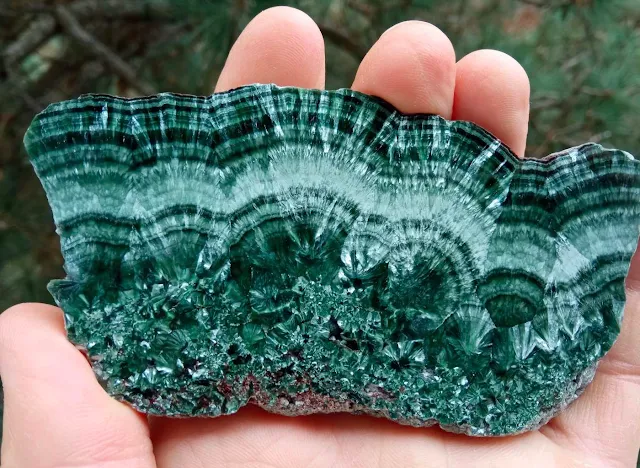Seraphinite: Feathery Gemstone, Formation, Uses
Seraphinite is a rare and stunning green gemstone known for its feathery, silvery streaks that resemble angel wings. These inclusions are actually mica deposits, giving the stone its unique shimmering beauty. Seraphinite is a type of clinochlore, a member of the chlorite mineral group.
The name, 'seraphinite' comes from a Greek word, seraphim, meaning a winged heavenly being, because of the feather-like appearance of the chatoyant fibers in the stone.
The mineral clinochlore was first identified in 1851 in West Chester, Pennsylvania. It has since been discovered in a number of other locales in the USA, including New York, Arizona and New Jersey. Clinochlore can also be found in other countries, including Spain, Switzerland, Russia, Turkey and Italy.
The dark green color of seraphinite is enhanced by a silvery and feathery shimmer caused by mica inclusions.
 |
| Seraphinite |
Seraphinite Occurrence and Formation
Seraphinite primarily arises through metamorphic processes, specifically regional metamorphism. During this geological phenomenon, preexisting rocks are subjected to elevated temperatures and pressures, triggering chemical and physical transformations. These changes lead to the formation of new minerals, including seraphinite.
The initial material for seraphinite formation typically consists of magnesium-rich rocks, such as dolomite, calcite, or serpentine. These rocks often harbor minerals like mica and talc, which play a crucial role in the subsequent transformations.
During the cooling and crystallization phase, the newly formed seraphinite mineral incorporates fibrous mica inclusions within its structure. These inclusions align along specific crystallographic directions, giving rise to seraphinite's characteristic chatoyancy. This phenomenon manifests as the shimmering, feathery effect observed when light interacts with the aligned inclusions.
The primary source of commercially viable Seraphinite is the Korshunovskoye iron skarn deposit in eastern Siberia, Russia. This deposit formed due to the interaction of molten magma with limestone and dolomite, creating the ideal metamorphic environment for seraphinite growth.
 |
| Seraphinite with featherlike inclusions |
Seraphinite Properties
Composition: Clinochlore, a member of the chlorite group. Chemical formula: (Mg₅, Fe³⁺)Al(Si₃Al)O₁₀(OH)₈
Color: Deep green with silvery-white chatoyant feathers, sometimes with golden flashes.
Luster: Vitreous to pearly on smooth surfaces, silky on sub-crystalline surfaces.
Streak: Greenish white to white.
Hardness: 2.5 to 3 on the Mohs scale (relatively soft).
Cleavage: Perfect in one direction, good in another.
Crystal Form: Usually massive, botryoidal, or scaly.
Density: 2.60 to 3.02 g/cm³ (variable depending on composition and inclusions).
Transparency: Opaque to translucent.
Fracture: Uneven, conchoidal.
Solubility: Insoluble in most acids, weakly soluble in concentrated sulfuric acid.
Magnetism: Non-magnetic.
Fluorescence: Weak to absent fluorescence under long-wave and short-wave ultraviolet light.
Pleochroism: Weak, with the parallel and perpendicular rays showing slightly different shades of green.
Refractive Index: 1.571 - 1.599 (variable depending on composition).
Seraphinite can exhibit chatoyancy, a special light effect where a shimmering band of light moves across the surface as the stone is turned.
 |
| Seraphinite feathery inclusions |
Where is Seraphinite Found
Seraphinite is primarily found in a limited area of eastern Siberia, Russia. It specifically occurs in the Korshunovskoye iron skarn deposit, located in the Irkutskaya Oblast. This deposit is considered the type locality for Seraphinite, meaning it's the first place it was discovered and officially recognized.
What are the uses of Seraphinite
Seraphinite, a stunning green gemstone adorned with feathery, silvery streaks resembling angel wings, boasts a variety of uses beyond its captivating beauty. Here's a glimpse into its diverse world:
Jewelry
Seraphinite's mesmerizing appearance makes it a popular choice for crafting exquisite jewelry. Its captivating chatoyancy, the shimmering play of light across its surface, is best showcased when cut into cabochons, smooth, rounded gemstones. These cabochons are then incorporated into:
- Pendants and necklaces: A captivating statement piece, drawing attention with its otherworldly charm.
- Rings: Adding a touch of earthy elegance to any ensemble.
- Earrings: Delicate and eye-catching, adding a touch of magic to your ears.
 |
| Seraphinite in a raw, natural form |
Crystal Healing
For centuries, Seraphinite has been revered for its powerful healing properties, particularly in the emotional and spiritual realms. It's believed to:
The romantic name and the association of seraphinite with angels has gained seraphinite a reputation as a healing gem that is good for nerves and brain cells.
- Open the heart chakra: Promoting love, compassion, and emotional well-being.
- Reduce stress and anxiety: Bringing calmness and inner peace.
- Ground and center energy: Creating a sense of stability and connection to the earth.
- Stimulate spiritual growth: Enhancing intuition and connection to the divine.
Decorative Objects
Seraphinite's captivating beauty extends beyond personal adornment. Its unique patterns and mesmerizing shimmer make it a sought-after material for crafting:
- Sculptures and figurines: Breathtaking art pieces that add a touch of nature's magic to any space.
- Bowls and vases: Functional objects transformed into stunning conversation starters.
Collectors' Item
Seraphinite's rarity and unique beauty make it a prized possession for mineral and gemstone enthusiasts. Its captivating chatoyancy and diverse patterns add an element of intrigue to any collection.




%20(1).webp)





